Substrates (Food Source)
Fresh wood
The decomposition of fresh wood is one of the most difficult tasks in all the myriad of metabolic activities on earth. Only a select group of organisms are capable of this task, and all of them are fungi. Often these fungi are called lignicolous, which is a specific nod to their ability to decompose the robust woody component: lignin. Not all decomposers of fresh wood are specifically attacking the lignin, but there is a distinct difference between those genera capable of dealing with fresh wood, and those who can not.
The most well known wood rotters are members of the large family Polyporaceae: the polypores. Other wood rotters include Pleurotis (Oyster mushrooms), Lentinus (Shitake mushrooms), and Armillaria (Honey mushrooms).
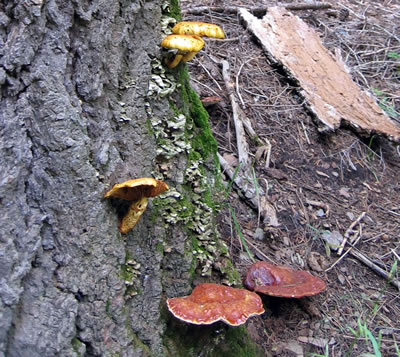
This photo contains three primary wood decomposers on the side of a dead Ponderosa Pine. At the bottom is Ganoderma oregonense, the brightly colored are a species of Pholiota, and the small grey brackets covering the side are likely Stereum or Trichaptum. .
Decayed wood
It is important to distinguish between freshly decomposing wood (listed above), and well rotted wood. The decomposition of lignin often facilitates the secondary colonization of a woody substrate by other fungi. These fungi are only capable of digesting the cellulose of the wood, but tend to outcompete the initial colonizers once the hard work is done. These fungi are more generalists, and often can be found in a wider variety of substrates.
Some of the more common secondary wood rotters are Lycoperdon (small puffballs), Coprinus (inky caps), Hypholoma, and even Agaricus.
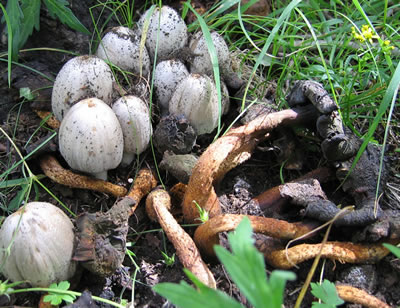
This image is an excellent example of facilitation and succession. These newly arising inky caps are decomposing the wood previously acted on by the primary wood rotter Pholiota.
Leaf and needle litter
(including grass thatch)
Litter substrates involve some of the most complex nutrient cycling in an ecosystem. A single pine needle can take up to 10 years to fully decompose, in the meantime it is processed by over one hundred different fungal species, each adapted to act on a different stage of decomposition facilitated by the actions of its predecessors.
Litter decomposers are a very large group, and are spread all across the taxonomic tree. These are your typical lawn mushrooms and many of the smaller, hard to identify varieties belong in this group. Forest floors can be "littered" with litter decomposer fruitings after rains. As a general rule, your chances of finding good mushrooms are directly related to the richness and depth of humus in the soil.
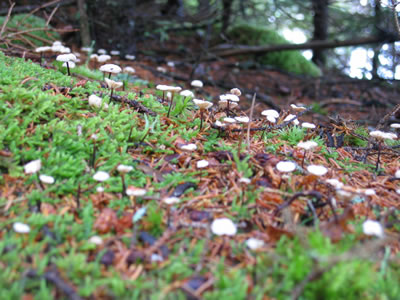
Common forest needle litter decomposers are Marasmius (pictured above).
Fertilized fields
Fields used for grazing are excellent locations for fungi that are especially good at decomposing the half-digested vegetation in ruminant dung. In nature these fungi were adapted mostly to deer and elk grazing, but with widespread livestock grazing, the populations of these fringe species have exploded. Fungi that specialize in utilizing dung as a nutrient source are called coprophilic (1, 2).
The most common and prized coprophilic mushrooms are in Coprinus, Agaricus, and Psilocybe. The commercially grown Agaricus varieties are almost exclusively cultivated on composted manure and horse straw. Please note that while some coprophilic fungi are specifically adapted to dung as a nutrient source, others like Agaricus merely benefit from the abundant nutrients present in grazed areas.
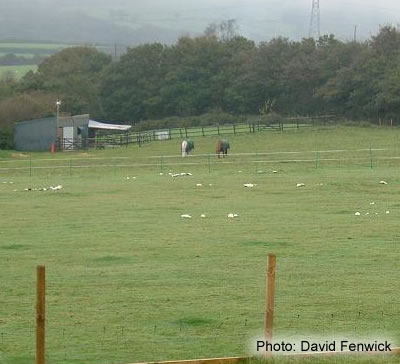
Soil (Mycorrhiza)
As mentioned in many other parts of this website, there is a large group of fungi that occupy the root systems of trees. When these fungi produce mushrooms, they will appear on the ground surrounding the tree they occupy. These terrestrial mushrooms can not be connected with any potential food source you will find where they appear. Simply by being on the ground, and not occupying wood or litter piles, you will have some clues as to their origin and identity.
In forests, you can expect to find many varieties of mycorrhizal mushrooms. Some of the most common are Amanita, Russula, Tricholoma, Cortinarius, and the boletes.
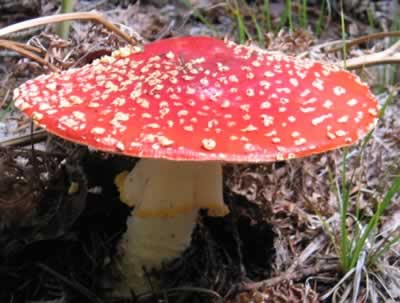
Amanita muscara, the fly agaric, a well known mycorrhizal fungus.